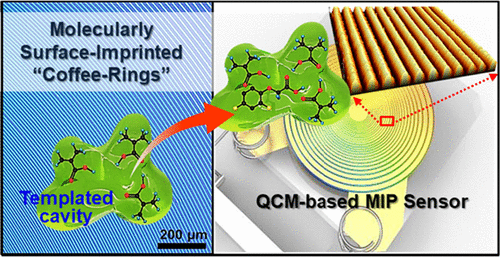当前位置:
X-MOL 学术
›
Biomacromolecules
›
论文详情
Our official English website, www.x-mol.net, welcomes your
feedback! (Note: you will need to create a separate account there.)
Enabling the Selective Detection of Endocrine-Disrupting Chemicals via Molecularly Surface-Imprinted “Coffee Rings”
Biomacromolecules ( IF 5.5 ) Pub Date : 2021-02-22 , DOI: 10.1021/acs.biomac.0c01748 Jihye Lee 1 , Jin Chul Yang 2 , Saifullah Lone 1 , Woon Ik Park 3 , Zhiqun Lin 4 , Jinyoung Park 2 , Suck Won Hong 1
Biomacromolecules ( IF 5.5 ) Pub Date : 2021-02-22 , DOI: 10.1021/acs.biomac.0c01748 Jihye Lee 1 , Jin Chul Yang 2 , Saifullah Lone 1 , Woon Ik Park 3 , Zhiqun Lin 4 , Jinyoung Park 2 , Suck Won Hong 1
Affiliation

|
Molecularly imprinted polymers (MIPs) represent an intriguing class of synthetic materials that can selectively recognize and bind chemical or biological molecules in a variety of value-added applications in sensors, catalysis, drug delivery, antibodies, and receptors. In this context, many advanced methods of implementing functional MIP materials have been actively studied. Herein, we report a robust strategy to produce highly ordered arrays of surface-imprinted polymer patterns with unprecedented regularity for MIP-based sensor platform, which involves the controlled evaporative self-assembly process of MIP precursor solution in a confined geometry consisting of a spherical lens on a flat Si substrate (i.e., sphere-on-flat geometry) to synergistically utilize the “coffee-ring” effect and repetitive stick–slip motions of the three-phase contact line simply by solvent evaporation. Highly ordered arrays of the ring-patterned MIP films are then polymerized under UV irradiation to achieve semi-interpenetrating polymer networks. The extraction of templated target molecules from the surface-imprinted ring-patterned MIP films leaves behind copious cavities for the recognizable specific “memory sites” to efficiently detect small molecules. As a result, the elaborated surface structuring effect, sensitivity, and specific selectivity of the coffee-ring-based MIP sensors are scrutinized by capitalizing on an endocrine-disrupting chemical, 2,4-dichlorophenoxyacetic acid (2,4-D), as an example. Clearly, the evaporative self-assembly of nonvolatile solutes in a confined geometry renders the creation of familiar yet ordered coffee-ring-like patterns for a wide range of applications, including sensors, scaffolds for cell motility, templates, substrates for neuron guidance, etc., thereby dispensing with the need of multistep lithography techniques and external fields.
中文翻译:

通过分子表面印迹的“咖啡环”选择性检测内分泌干扰物
分子印迹聚合物(MIP)代表一类有趣的合成材料,可以在传感器,催化,药物输送,抗体和受体的各种增值应用中选择性地识别并结合化学或生物分子。在这种情况下,已经积极研究了许多实施功能性MIP材料的高级方法。在本文中,我们报告了一种可靠的策略,可以为基于MIP的传感器平台生产具有空前规律性的高度有序排列的表面印迹聚合物图案阵列,其中包括在球形透镜组成的有限几何形状中,MIP前体溶液的受控蒸发自组装过程在平坦的Si基板上(即,简单地通过溶剂蒸发来协同利用“咖啡环”效应和三相接触线的重复粘滑运动来协同使用。然后,在紫外光照射下将高度有序排列的环形MIP薄膜阵列聚合,以实现半互穿聚合物网络。从表面印有环形图案的MIP膜中提取模板化的目标分子后,留下了大量空腔,用于识别可识别的特定“记忆位点”,以有效地检测小分子。结果,通过利用破坏内分泌的化学物质2,4-二氯苯氧基乙酸(2,4-D)来研究基于咖啡环的MIP传感器的精细表面结构化效果,灵敏度和比选择性,一个例子。清楚地,
更新日期:2021-04-12
中文翻译:

通过分子表面印迹的“咖啡环”选择性检测内分泌干扰物
分子印迹聚合物(MIP)代表一类有趣的合成材料,可以在传感器,催化,药物输送,抗体和受体的各种增值应用中选择性地识别并结合化学或生物分子。在这种情况下,已经积极研究了许多实施功能性MIP材料的高级方法。在本文中,我们报告了一种可靠的策略,可以为基于MIP的传感器平台生产具有空前规律性的高度有序排列的表面印迹聚合物图案阵列,其中包括在球形透镜组成的有限几何形状中,MIP前体溶液的受控蒸发自组装过程在平坦的Si基板上(即,简单地通过溶剂蒸发来协同利用“咖啡环”效应和三相接触线的重复粘滑运动来协同使用。然后,在紫外光照射下将高度有序排列的环形MIP薄膜阵列聚合,以实现半互穿聚合物网络。从表面印有环形图案的MIP膜中提取模板化的目标分子后,留下了大量空腔,用于识别可识别的特定“记忆位点”,以有效地检测小分子。结果,通过利用破坏内分泌的化学物质2,4-二氯苯氧基乙酸(2,4-D)来研究基于咖啡环的MIP传感器的精细表面结构化效果,灵敏度和比选择性,一个例子。清楚地,











































 京公网安备 11010802027423号
京公网安备 11010802027423号